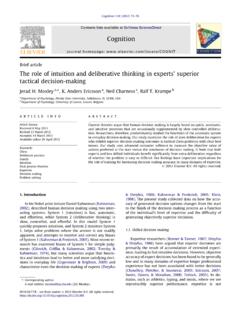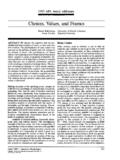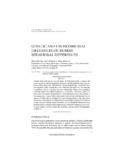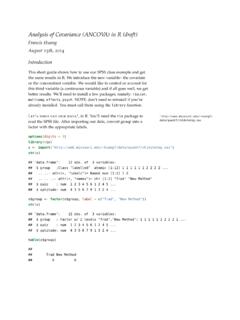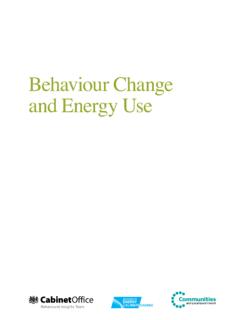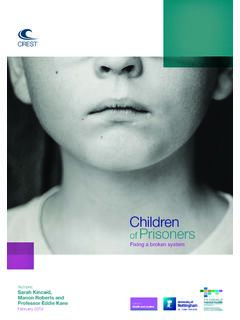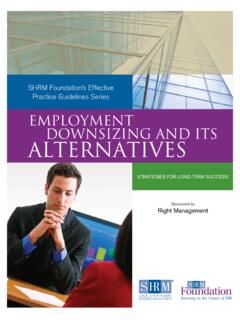Transcription of Evolution of Human Mate Choice - University of Missouri
1 Evolution of Human Mate Choice David C. Geary, Jacob Vigil, and Jennifer Byrd-Craven University of Missouri Columbia This article provides a review of evolutionary theory and empirical research on mate choices in non- Human species and used as a frame for understanding the how and why of Human mate choices. The basic principle is that the preferred mate choices and attendant social cognitions and behaviors of both women and men, and those of other species, have evolved to focus on and exploit the reproductive potential and reproductive investment of members of the opposite sex. Reproductive potential is defined as the genetic, material, and (or) social resources an individual can invest in offspring, and reproductive investment is the actual use of these resources to enhance the physical and social well being of offspring. Similarities and differences in the mate preferences and choices of women and men are reviewed, and can be understood in terms of simi- larities and differences in the form reproductive potential that women and men have to offer and their tendency to use this potential for the well- being of children.
2 The study of Human sexual behavior and Human sex dif- mechanisms that operate within species and are principle ferences has been approached from many vantage points factors in the Evolution of sex differences (Darwin, 1871). (Davidson & Moore, 2001; McGillicuddy-De Lisi & De These mechanisms are called sexual selection and involve Lisi, 2002) and in recent years has been viewed through the competition with members of the same sex over mates lens of evolutionary theory (Buss, 1994; Campbell, 2002; (intrasexual competition) and discriminative Choice of mat- Geary, 1998; Low, 2000; Symons, 1979). However, many ing partners (intersexual Choice ). The most common mat- psychologists, social scientists, and social critics are reluc- ing dynamic involves male-male competition over access to tant and sometimes vigorously opposed to understanding mates and female Choice of mating partners (Andersson, Human behavior in general and Human sexuality in particu- 1994).
3 In the first section, we describe why this dynamic is lar from an evolutionary perspective (Segerstrale, 2000), or so common and when exceptions ( , male Choice ) are at the very least argue that social influences are predomi- predicted to evolve. In the second section, we describe nant (Wood & Eagly, 2002). Our goal is not to address the intersexual Choice in nonhuman species. attendant philosophical or social issues, but rather to pro- Compete or Choose? vide an introduction to the theory and empirical research generated from the evolutionary perspective. In particular, Darwin (1871) defined sexual selection, but did not deter- we focus on women's and men's preferences and choices of mine why males tend to compete over mates and why mates and marriage partners, and invite the reader to judge females are the choosier of the sexes (see Cronin, 1991). for himself or herself the utility of this approach.
4 About 100 years later, Williams (1966) and Trivers (1972). In the first section, we provide an introduction to the the- determined that any sex difference in the tendency to com- oretical and empirical literatures on mate choices in other pete or choose largely but not exclusively turns on the species (Andersson, 1994; Darwin, 1871) and the frame- degree of each sexes' investment in parenting. The sex that work for appreciating the advantages of this approach for provides more than his or her share of parental investment understanding Human mate choices. In the second and third becomes, in effect, an important reproductive resource for respective sections, we provide overviews of evolutionary members of the opposite sex (Dawkins, 1989; Trivers, research on women' and men's mate choices. In the final 1972). One result is competition among members of the section, we describe how Human mate choices are moder- lower investing sex (typically males) over the parental ated by social and ecological conditions.
5 Investment of members of the higher investing sex (typi- cally females). Members of the higher investing sex are MATE Choice IN NONHUMAN SPECIES thus in demand, and can be choosy when it comes to Darwin and Wallace (1858) independently discovered the mates. Clutton-Brock and Vincent (1991) determined that primary mechanisms ---natural selection that drive evo- any sex difference in the tendency to parent is linked to a lutionary change within species and result in the origin of sex difference in the potential rate of reproduction. As we new species. Darwin also discovered another group of describe in the next sections, the potential rate of repro- duction interacts with social conditions, in particular the We thank Joe LoPiccolo for comments on an earlier draft. operational sex ratio (OSR), to create mating dynamics. Address correspondence to David C. Geary, Department of Psychology, 210.
6 Mechanisms that operate within species and are McAlester Hall, University of Missouri , Columbia, MO 65211-2500; email: pr Sex Differences in Rate of Reproduction The basic issue is the biological limit on how many offspring The Journal of Sex Research Volume 41, Number 1, February 2004: 27. 28 Mate Choice males and females can potentially produce in their lifetime. to invest more in parenting than males, female Choice is The upper limit is determined by how fast the individual more common than male Choice (Andersson, 1994;. can potentially reproduce (Clutton-Brock & Vincent, Darwin, 1871; Trivers, 1972) and has been demonstrated 1991). The biological limit for female mammals is deter- across species of bird, insect, fish, reptile, and mammal mined by gestation time and length of postpartum suckling. (Andersson, 1994; Sargent, Rush, Wisenden, & Yan, 1998).
7 The limit for male mammals, in contrast, is determined by One result of female Choice is the Evolution of exaggerated the number of females to which they gain sexual access. In male traits. An example is shown in Figure 1, where hum- any given breeding season, females will typically have one mingbird females choose mates in part based on the length offspring, whereas males who successfully compete for of the males' tail feathers. Traits such as those shown in access to females will have many offspring. Figure 1 are typically an indicator of the physical or genet- The predicted result of the sex difference in rate of ic health of the male or serve as an indicator of his ability reproduction is an evolved bias of mammalian females ( , vigor in searching for food) to provide parental toward high levels of parental investment (which includes investment (Andersson, 1994; Zahavi, 1975).)
8 Gestation and suckling) and mammalian males toward com- The physical and genetic health of males is related, in petition for mates and no parental investment. This pattern part, to immunocompetence---that is, the ability to resist is found in more than 95% of mammalian species (Clutton- infection by parasites in the local ecology (Folstad & Karter, Brock, 1989). The corresponding behavioral biases are a 1992; Hamilton & Zuk, 1982). It appears that immunocom- male preference for multiple mates and more variability in petence is heritable and thus the offspring of males with reproductive outcomes across males than females. Some exaggerated traits survive in greater numbers than do the males sire many offspring, and many males sire no offspring of other males (Saino, M ller, & Bolzern, 1995;. off-spring, a dynamic that intensifies male-male competition. Saino, Primmer, Ellegren, & M ller, 1997).
9 Thus, male ornaments are barometers that are strongly affected by the Operational Sex Ratio condition of the male, and female mate choices reflect the The OSR is the ratio of sexually active males to sexually Evolution of females' ability to read these barometers. active females in a given breeding population and is relat- Although the research in this area is less extensive, there is ed to the rate of reproduction (Emlen & Oring, 1977). In a population where there are as many sexually mature Figure 1. Female (left) and male (right) humming birds females as males---an actual sex ratio of 1:1---any sex dif- (Spathura underwoodi). From The descent of ference in the rate of reproduction will skew the OSR. As man, and selection in relation to sex (Vol. II, noted, male mammals have a faster potential rate of repro- p. 77), by C. Darwin, 1871, London: John Murray.
10 Duction than female mammals and thus there are typically Copyright by John Murray. Reprinted with permission many more sexually receptive males than females in most populations. The resulting bias leads to intense male-male competition over access to a limited number of sexually receptive females. Male-male competition, in turn, creates the conditions under which female choosiness can evolve (Andersson, 1994). For species in which females have a faster rate of reproduction ( , when males incubate eggs), females compete and males choose (Amundsen, 2000; Reynolds & Szekely, 1997). In some situations, the sex with the higher potential rate of reproduction is better off investing in parenting than in competing for mates. One example is provided by cal- litrichid monkeys. Here, shared territorial defense, con- cealed ovulation, female-on-female aggression, twinning, and perhaps other yet unknown factors functionally negate the sex difference in the potential rate of reproduction and result in a more balanced OSR, monogamy, and high levels of male parenting (Dunbar, 1995).
